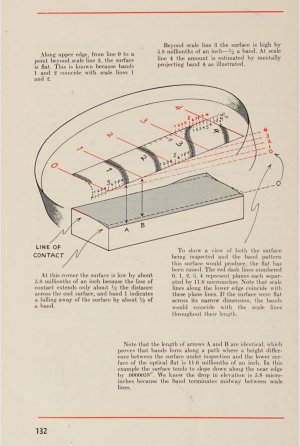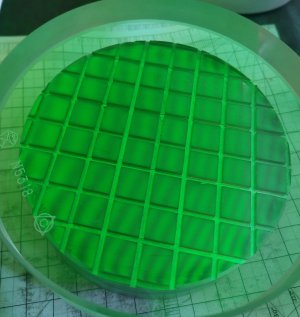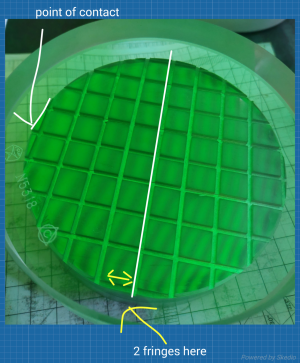What do the fringes do when you press on the flat? The fact that the fringes are spaced very uniformly across the lap suggests that the flat is tilted with respect to the lap, perhaps due to a particle or hair. I counted about 30 fringes from one side to the other, that comes to about 30*(532/4) nm or about 4 microns worth of tilt, assuming it's uniform across that expanse. It also could be due to a cylindrical surface profile but I doubt that, since the fringes are so regularly spaced.
You indicated that you started out with something that is flat to about 1micron so something is amiss.
I have since found some really good books on the optical flat use and I've educated myself better on the subject

More about it below. But first let me say thank you for your intention of helping me, but you're not reading the image correctly.
There is always tilt with optical flats. A wedge of air forms and by manipulating that wedge's thickness one can sort of magnify or zoom out the view. What you're seeing here is the zoomed out view. You don't count all the fringes the way you did to discover surface flatness. This just tells you how far the optical flat is tilted (as you mentioned too).
The way to discover surface curvature is this:

So you have to look at a given fringe (number 3 on image above) and see how far it curves in relation to the width between fringes. The width between fringes is your unit of measurement. Weather there are 3 or 30 fringes doesn't matter, only their curvature does. In the pictures I attached it is difficult to tell the exact curvature precisely because of that zoomed out view and the fact it is split into 3 images. It is somewhere in the region of 1. 5~3 fringes. So in the region of 1 micron or a bit under still.
I've also found fringes get smeared out by the lack of good surface reflectivity and quality the more zoomed in you want to make the view the more reflective the surface has to be. So to really properly judge a surface down to a quarter of a fringe it needs to be mirror quality.
I've since done some polishing (and a little selective lapping) and I managed to get really nice 1~2 fringe across the entire disk(depending on which of 3 laps). However, I found there is a problem capturing fringe images with a cellphone camera when the wedge od air is almost gone. The cellphone camera "created it's own" circular fringe that is invisible by eye and it moves with the point of view. I think it is the reflection off the top of the flat that causes it.
So the most zoomed in view I can capture is this one:

And it is good enough we can analyze it(sort of). Here is my "analysis" :

The difficulty in reading this is mostly that the point of contact changes if you press on it, the wedge of air gets thinner or thicker, also you see a different picture I'm your left and right eye because the fringe pattern location depends on exact point if view... It is not easy. In a way projecting the image onto a wall is much better, but I don't have the optics to cover the entire surface of the item in a coherent beam and I'm mostly interested in the entire surface nit individual squares.
Edit: I forgot to mention the book this page is from. It is "The science of precision measurement" by DoAll company. I recommend the book to anyone interested in optical flat measurement. You can read it for free here (account needed) :
https://archive.org/details/scienceofprecisi0000vari/mode/1up



